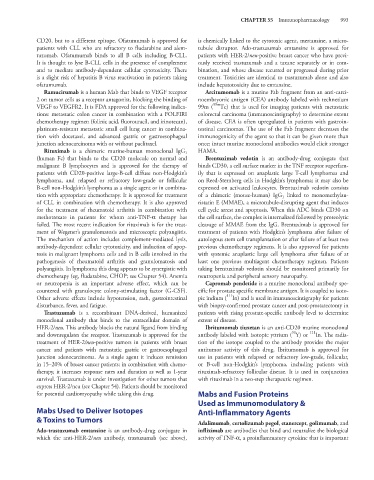Page 1007 - Basic _ Clinical Pharmacology ( PDFDrive )
P. 1007
CHAPTER 55 Immunopharmacology 993
CD20, but to a different epitope. Ofatumumab is approved for is chemically linked to the cytotoxic agent, mertansine, a micro-
patients with CLL who are refractory to fludarabine and alem- tubule disruptor. Ado-trastuzumab emtansine is approved for
tuzumab. Ofatumumab binds to all B cells including B-CLL. patients with HER-2/neu-positive breast cancer who have previ-
It is thought to lyse B-CLL cells in the presence of complement ously received trastuzumab and a taxane separately or in com-
and to mediate antibody-dependent cellular cytotoxicity. There bination, and whose disease recurred or progressed during prior
is a slight risk of hepatitis B virus reactivation in patients taking treatment. Toxicities are identical to trastuzumab alone and also
ofatumumab. include hepatotoxicity due to emtansine.
Ramucirumab is a human Mab that binds to VEGF receptor Arcitumomab is a murine Fab fragment from an anti-carci-
2 on tumor cells as a receptor antagonist, blocking the binding of noembryonic antigen (CEA) antibody labeled with technetium
VEGF to VEGFR2. It is FDA approved for the following indica- 99m ( 99m Tc) that is used for imaging patients with metastatic
tions: metastatic colon cancer in combination with a FOLFIRI colorectal carcinoma (immunoscintigraphy) to determine extent
chemotherapy regimen (folinic acid, fluorouracil, and irinotecan), of disease. CEA is often upregulated in patients with gastroin-
platinum-resistant metastatic small cell lung cancer in combina- testinal carcinomas. The use of the Fab fragment decreases the
tion with docetaxel, and advanced gastric or gastroesophageal immunogenicity of the agent so that it can be given more than
junction adenocarcinoma with or without paclitaxel. once; intact murine monoclonal antibodies would elicit stronger
Rituximab is a chimeric murine-human monoclonal IgG HAMA.
1
(human Fc) that binds to the CD20 molecule on normal and Brentuximab vedotin is an antibody-drug conjugate that
malignant B lymphocytes and is approved for the therapy of binds CD30, a cell surface marker in the TNF receptor superfam-
patients with CD20-positive large-B-cell diffuse non-Hodgkin’s ily that is expressed on anaplastic large T-cell lymphomas and
lymphoma, and relapsed or refractory low-grade or follicular on Reed-Sternberg cells in Hodgkin’s lymphoma; it may also be
B-cell non-Hodgkin’s lymphoma as a single agent or in combina- expressed on activated leukocytes. Brentuximab vedotin consists
tion with appropriate chemotherapy. It is approved for treatment of a chimeric (mouse-human) IgG linked to monomethylau-
1
of CLL in combination with chemotherapy. It is also approved ristatin E (MMAE), a microtubule-disrupting agent that induces
for the treatment of rheumatoid arthritis in combination with cell cycle arrest and apoptosis. When this ADC binds CD30 on
methotrexate in patients for whom anti-TNF-α therapy has the cell surface, the complex is internalized followed by proteolytic
failed. The most recent indication for rituximab is for the treat- cleavage of MMAE from the IgG. Brentuximab is approved for
ment of Wegener’s granulomatosis and microscopic polyangiitis. treatment of patients with Hodgkin’s lymphoma after failure of
The mechanism of action includes complement-mediated lysis, autologous stem cell transplantation or after failure of at least two
antibody-dependent cellular cytotoxicity, and induction of apop- previous chemotherapy regimens. It is also approved for patients
tosis in malignant lymphoma cells and in B cells involved in the with systemic anaplastic large cell lymphoma after failure of at
pathogenesis of rheumatoid arthritis and granulomatosis and least one previous multiagent chemotherapy regimen. Patients
polyangiitis. In lymphoma this drug appears to be synergistic with taking brentuximab vedotin should be monitored primarily for
chemotherapy (eg, fludarabine, CHOP; see Chapter 54). Anemia neutropenia and peripheral sensory neuropathy.
or neutropenia is an important adverse effect, which can be Capromab pendetide is a murine monoclonal antibody spe-
countered with granulocyte colony-stimulating factor (G-CSF). cific for prostate specific membrane antigen. It is coupled to isoto-
111
Other adverse effects include hypotension, rash, gastrointestinal pic indium ( In) and is used in immunoscintigraphy for patients
disturbance, fever, and fatigue. with biopsy-confirmed prostate cancer and post-prostatectomy in
Trastuzumab is a recombinant DNA-derived, humanized patients with rising prostate-specific antibody level to determine
monoclonal antibody that binds to the extracellular domain of extent of disease.
HER-2/neu. This antibody blocks the natural ligand from binding Ibritumomab tiuxetan is an anti-CD20 murine monoclonal
90
and downregulates the receptor. Trastuzumab is approved for the antibody labeled with isotopic yttrium ( Y) or 111 In. The radia-
treatment of HER-2/neu-positive tumors in patients with breast tion of the isotope coupled to the antibody provides the major
cancer and patients with metastatic gastric or gastroesophageal antitumor activity of this drug. Ibritumomab is approved for
junction adenocarcinoma. As a single agent it induces remission use in patients with relapsed or refractory low-grade, follicular,
in 15–20% of breast cancer patients; in combination with chemo- or B-cell non-Hodgkin’s lymphoma, including patients with
therapy, it increases response rates and duration as well as 1-year rituximab-refractory follicular disease. It is used in conjunction
survival. Trastuzumab is under investigation for other tumors that with rituximab in a two-step therapeutic regimen.
express HER-2/neu (see Chapter 54). Patients should be monitored
for potential cardiomyopathy while taking this drug. Mabs and Fusion Proteins
Used as Immunomodulatory &
Mabs Used to Deliver Isotopes Anti-Inflammatory Agents
& Toxins to Tumors Adalimumab, certolizumab pegol, etanercept, golimumab, and
Ado-trastuzumab emtansine is an antibody-drug conjugate in infliximab are antibodies that bind and neutralize the biological
which the anti-HER-2/neu antibody, trastuzumab (see above), activity of TNF-α, a proinflammatory cytokine that is important

